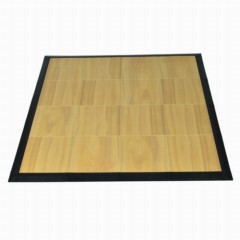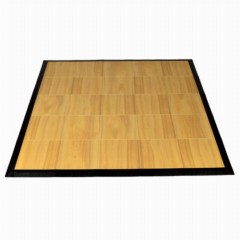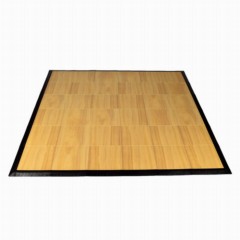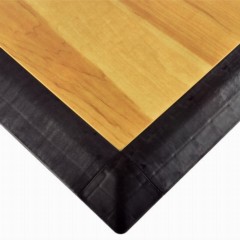Laminate Roll Flooring, Vinyl Laminate Planks and Tiles
One of the most versatile types of flooring we offer at Greatmats is found in our various models of vinyl laminate flooring. Customers can use this type of floor in a variety of locations, creating a look that resembles real wood or stone.
Vinyl flooring works for basements, home gyms, trade shows, yoga studios, dance studios, basketball courts, volleyball courts, and more. Many of our vinyl laminate flooring products are easy to install, so you can perform a DIY job to create the flooring layout, saving money versus hiring a professional.
Size and Shape Options
These floors come in a variety of styles, including rolls, tiles, and planks. Select the format that best fits the planned use case and the installation expertise that you have for the project.
- Roll: Rolls of vinyl sheets help cover a large room in a short amount of time, but they can be a little tougher to install. We offer a roll measuring 6x30 feet that includes foam padding attached to the underside, making it ideal for athletic facilities.
- Tile: LVT, or luxury vinyl tile, is a common style that we offer at Greatmats. These tiles can have hidden interlocking edges or puzzle-style edges to simplify installation without the need to use glue.
- Plank: LVP, or luxury vinyl plank, appears rectangular. These planks often use a tongue and groove or click system on the edges to simplify interlocking the planks during installation.
Material Options
Vinyl laminate flooring offers several benefits. For starters, vinyl is waterproof, so if someone spills a beverage or if your pet has an accident, you have time to clean it up because it will not soak into the flooring.
Additionally, vinyl is available in many different color options, providing significant versatility. Manufacturers print a pattern on the vinyl layer, commonly creating the look of a hardwood floor. Other options include creating vinyl laminate flooring that looks like stone tile.
The supporting base layer for the vinyl often will feature a durable plastic. This gives the floor significant support to hold heavy furniture or to support frequent foot traffic without feeling wobbly.
We also offer some vinyl floors that make use of a foam layer underneath, delivering cushioning for workouts that protects the lower body joints of the athletes using the floor.
Pattern and Texture Options
The most common pattern found on vinyl laminate flooring is a wood grain pattern. This is a highly realistic wood grain, containing different shades of color and faux knots.
Gray, light brown, and dark brown wood colors are common with vinyl floors. Some of these floors may feature printed wood grains that look like oak or maple.
You also may find some luxury vinyl floors that resemble stone. They will include a variety of colors and random swirling patterns to create a realistic look.
Vinyl tiles, rolls, and planks rarely carry a texture on the top layer. Most of them have a smooth finish, which simplifies cleaning processes.
Common Use Options
Vinyl laminate flooring works well in both residential and commercial locations. Its high-end look fits almost any circumstance, yet it remains easy to clean and maintain.
In a residence, homeowners may choose to use it in basements, bathrooms, or kitchens -- all areas where spills or other types of moisture may be present. Some people choose to install vinyl flooring in a laundry room or mud room because it is easy to clean and highly durable.
For commercial layouts, it commonly appears in gymnasiums as sports flooring. The vinyl works well for aerobics classes and yoga classes, too. Business owners may want to install the vinyl in a customer-facing area to create a sense of luxury. It also works nicely in a trade show booth.
Installation Options
Customers often can install these tiles and planks on their own, even if they don’t have much experience with flooring installs.
Vinyl tiles often have interlocking edges that simply pop together to secure the layout without the need to add glue to the edges.
Vinyl planks do not need glue either, as they lock together through the use of tongue and groove edges.
For vinyl rolls, most manufacturers recommend using adhesive to connect them to the subfloor. Only use a brand and style of adhesive that the manufacturer of the vinyl flooring recommends as safe.
Cleaning and Maintenance Requirements
Vinyl is easy to clean and maintain, no matter which style you choose to install. Most of our vinyl products have a urethane coating over the top that protects the printed layer from wear and tear.
Simply clean dust and other solid debris from the top of the floor regularly to keep the flooring looking like new. A broom, a vacuum cleaner, or a dust mop can do the job adequately.
Mop the floor with a neutral pH cleaner or another gentle floor cleaner to remove stubborn soils. Do not use cleaners that contain bleach or harsh abrasives. Allow the floor to dry naturally over time, rather than introducing heat to speed up the drying process.







